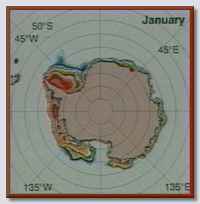Surrounding Antarctica are the southern parts of the Pacific, Atlantic and Indian Oceans. The "Antarctic Convergence", which encircles Antarctica roughly 1,500 kilometers off the coast, divides the cold southern water masses and warmer northern waters. An ocean current, the world's largest, moves eastward around the continent at an average speed of about half a knot.
Experiment for yourself: click on the green button to see how Antarctica doubles in size each southern winter as the ice expands out from the shore! |
|
|
Sea ice up to 3 meters thick expands outward from the continent every winter, making a belt 500 to 1,500 kilometers wide, just about doubling the size of the continent. Even in summer the sea ice belt is 150 to 800 kilometers in most places. The area of sea ice varies from 3 million square kilometers in summer to 20 million square kilometers in late winter.
|
Antarctica: an island continent at the end of our planet
The Southern Ocean isolates the Antarctic continent from the rest of the world. Surrounding the continent are two concentric water masses. The more northerly tends to move in a westerly direction under the influence of the prevailing winds (the West Wind Drift), while the water nearest the continent circulates in the opposite direction (the East Wind Drift). Superimposed on these circumpolar movements is a tendency for the surface water to drift to the north.
At its northern limit, the cold Antarctic surface water sinks beneath the less dense sub-Antarctic surface water. The region where this sinking occurs is referred to as the Antarctic Convergence, or Polar Front. At the Convergence there is a sudden change in temperature. An increase in nutrient salts occurs south of the Convergence, contributing to the richer, more productive marine ecosystem found here, compared with the sub-Antarctic surface waters north of the Convergence.
Adapted, with thanks, from NSF's "Facts about the U.S. Antarctic Program"
Websites
• Poles
Describes the location and facts about the South Pole including the difference between the magnetic, geographic and geomagnetic pole.
• Ice Shelves
Facts about ice shelves.
• Ice cores and climate change
An explanation as to how our climate has changed over the years and how ice cores show us that record.
• Antarctic Adventure 1997
Information on the geography and climate of Antarctica.
• Meteorology
A general description of the climate of Antarctica.
• Antarctic Prehistory Introduction
Background information on the prehistory of Antarctica.
• Antarctic Prehistory
More background information on the prehistory of Antarctica.
![]()
